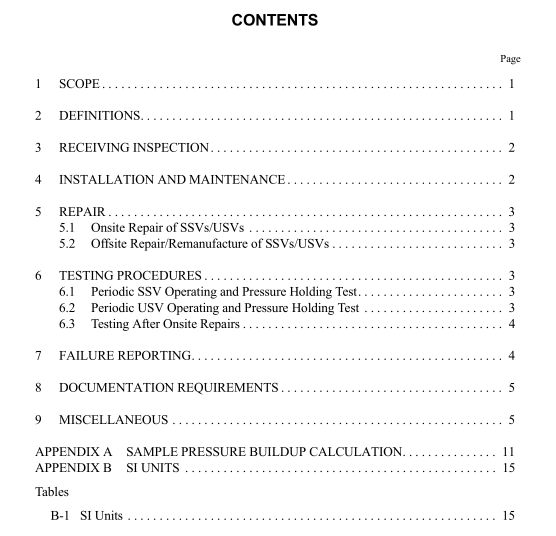API RP 14H pdf download

API RP 14H pdf download Recommended Practice for Installation, Maintenance and Repair of Surface Safety Valves and Underwater Safety Valves Offshore
1 Scope
1.1One of the means of assuring positive welstrean shutoff is the use of the wellhead surface safety valve (SSV) or underwatersafety valve (USV). It is imperative that the SSV/USV be mechanically reliable. It should therefore be operated, tested and main-tained in a manner to assure continuously reliable performance.
1.2 The purpose of this Recommended Practice (RP) is to provide guidance for inspecting, installing, operating, maintaining,and onsite repairing SSVsUSVs manufactured according to APl Spec 6A(17th Edition or later), Clause 10.20 or APl Spec 14D(withdrawn). Included are procedures for testing ssVs/USVs.
1.3This RP covers guidelines for inspecting, installing,maintaining, onsite repairing, and operating SSvs/USvs. Nothing inthis RP is to be construed as a fixed rule without regard to sound engineering judgment nor is it intended to override applicablefederal,state or local laws.
2Definitions
The following definitions are related specifically to surface safety valves and underwater safety valves and are presented to definethe terminology used in this standard.
2.1failure: Improper performance of a device or equipment item that prevents completion of its design function.
2.2heat sensitive lock open device: A device installed on a SSV actuator to maintain the SSV valve in a full open posi-tion until exposed to sufficient heat to cause the device to release and allow the ssV valve to close.
2.3manufacturer:The principal agent in the design, fabrication, and furnishing of a SSVIUSV actuator andor SSVUsvvalve.The SSVuUsv valve and SsvUSV actuator define functional entities and do not necessarily represent the units as supplied.2.4 operating manual: The publication issued by the manufacturer containing detailed data and instructions related to thedesign, installation, operation, and maintenance of ssv/usv equipment.
2.5operator: The user of a ssv/usV who chooses to comply with this standard.
2.6 qualified part: A part manufactured under an authorized quality assurance program and, in the case of replacement, pro-duced to meet or exceed the performance of the original part.
2.7 qualified person: An individual with characteristics or abilities gained through training or experience or both as mea-sured against established requirements such as standards or tests that enable the individual to perform a required function.
2.8 remanufacture: Activity involving disassembly, reassembly, and testing of the SSVIUsv, with or without the replace-ment of parts, where machining, welding, heat treating or other manufacturing operations are employed.
Note: Remanufacture does not include the replacement of bodies.
2.9repair: Any activity that involves either replacement with qualified parts or disassembly/reassembly of the SSVUSV.Repair may be offsite or onsite as described below.
2.9.1 offsite repair: Activity performed at a location other than the equipment installation site which restores the equipmentto its original performance meeting the requirements of the edition of API Spee 6A in effect at the time of original manufacture,as a minimum.
2.9.2 onsite repair:Activity performed in accordance with this RP at the equipment installation site.
2.10 Surface Safety Valve (SSV): An automatic wellhead valve assembly that will close upon loss of power supply. Whenused in this standard it includes the SsV valve, ssV actuator, and heat sensitive lock-open device.
2.11 ssv/usV actuator: The device that causes the SSVIUSv valve to open when power is supplied and to automaticallyclose when power is lost or released.
2.12 ssvusV valve: The portion of the SSV/USV that contains the wellstrean and shuts off flow when closed.
2.13 tree, christmas: An assembly of valves and fittings used for production control that includes, as applicable, the tubinghead top flange, the bottom most master valve, the crown valve(swabbing valve), the wellhead choke, and all valves and fittingsin between.
2.14 valve, master: A valve located in the vertical run of a christmas tree whose primary purpose is to shut off well flow.2.15 valve, wing: A valve located on the christmas tree, but not in the vertical run, which can be used to shut off well flow.2.16 Underwater Safety Valve (UsV);: An automatic valve assembly (installed at an underwater wellhead location) thatwill close upon loss of power supply. When used in this standard, it includes the USV valve and USV actuator.
3Receiving Inspection
3.1 Upon receipt of the SSV/usv at the wellsite, check the SSV/usV documentation to verify the following:a. The serial numbers on the SsVUsv correspond to those recorded on the accompanying receiving report.b. The SsV/UsV valve and SSV/USV actuator are the proper size and pressure rating for the service intended.
c. The SSvuSv valve is marked for the class of service (14D valves) or material class (6A,10.20 valves) to which it may besubjected as outlined in API Spec 6A.
3.2Check the SsV/usV for visible damage that might impair its proper operation.
Note: Disassembly of the SSVusV for inspection must not be attempted by other than qualified personnel and should be in accordance with themanufacturer ‘s, operating manual.
4lnstallation and Maintenance
4.1 The SsV should be the second valve in the wellhead flowstream (e.g, if two master valves are used, the SSV should be thetop master valve; if a single master valve is used, the SSV should be the wing valve).The USV should be in a practical location inthe wellhead flowstream and within reasonable proximity of the well bore.









